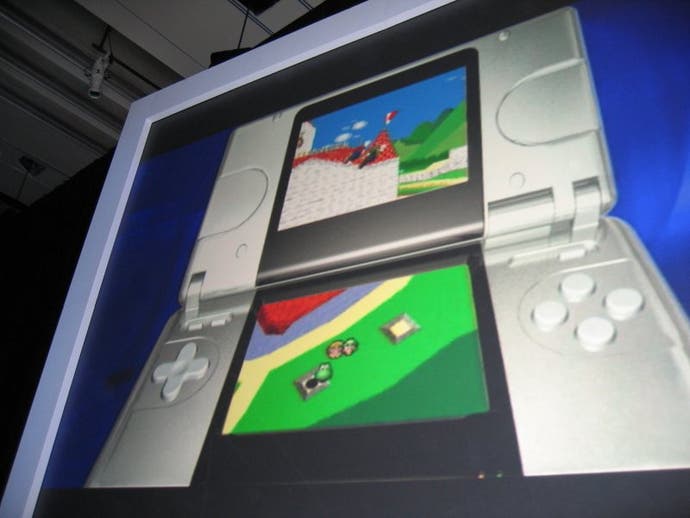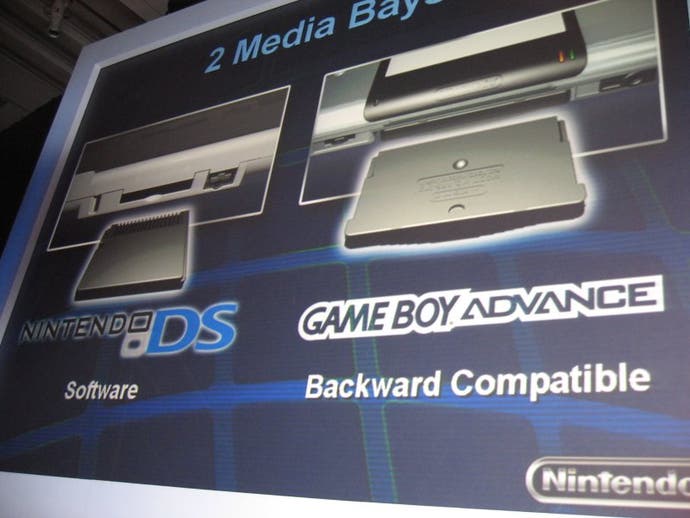Nintendo DS disassembled
We dissect the hardware side of Nintendo's latest handheld, considering every aspect of the unit premiered in Los Angeles just hours ago...
For the last few months, Nintendo DS has been the subject of much speculation, the victim of a misguided derision, and the recipient of certain amount of cautious optimism. But that could be about to change.
Judging by the overwhelming third-party commitment, vast array of innovative features and games, and undeniably impressive video footage on display at Nintendo's pre-E3 conference this year, the next few weeks could well be dominated by the screeching grind of changing gears. One journo in particular sat close to us at the conference was denouncing the console before it all kicked off, only to emerge from the Hollywood Renaissance Hotel Grand Ballroom as one of its loudest proponents.
Different System

But you've heard all this before. Pre-E3 conferences and hyperbole go hand in hand. So much so in fact that when something genuinely intriguing and innovative like the DS comes along, the ranks of press and trade are forced to go out and try to convince people of its significance in new and innovative ways. For them to do so though will be a fitting tribute to the system, which is so different to every other console system we've seen in the past that each surprising revelation made by Nintendo representatives was soon topped by the next.
There is no question that it's different. The real question will be whether it's different in better and genuinely useful ways. It's a question we hope to start answering tomorrow when we go hands on with the DS software on the E3 show floor. If the amount of third party support and video testimonials were anything to go by though, it's so different that developers just aren't sure where to start - and this level of change is coaxing them all into thinking of wildly different ways of approaching the console.
It's exciting for developers - when Nintendo of America's Reggie Fils-Aime likened the current console cycle to driving a bit faster down the same road with each new generation of car, you could tell a lot of people in the room felt the same. Judging by the wide range of comments made with regards to this system, and the diverse range of software we've seen, we're not only looking at a new car in the DS, but a new road and a new set of pedals and gears to boot, and as a result developers are understandably signing up to the cause.
Touch screen, backwards compatibility

First of all - Nintendo DS is a dual screen handheld comprising two 256x192 screens (compared to the GBA's 240x160), with a D-pad that ought to fit any human thumb on the left hand side of the lower screen, and an equally spaced diamond of function buttons on the right. What appear to be Select and Start buttons are located above the D-pad below the fold of the clamshell unit, with another similarly small function button located in the top-right corner of the lower half of the unit (its use still to be determined). Shoulder buttons weren't visible, but could still be there. At left and right opposite ends of the near side edge of the lower half are power and volume controls, the latter next to a headphone socket.
The lower of the DS' two screens will be touch-sensitive, responding both to a supplied stylus and fingertip, and we'll touch (ha!) on the ramifications of that development a bit later on. The cartridge slot for the DS own games, which are to be distributed on SmartMedia-sized cards with a capacity of "1 Gigabit", is located on the lower half of the unit beneath the hinge, next to a GBA-style link-up cable port.
The DS will also be backwards compatible with all Game Boy software, with a port for GBA/GB carts located in the centre of the nearside edge of the lower half. This is sure to rekindle speculation that Nintendo sees the DS as a GBA replacement, but the platform holder didn't touch on this in its lengthy presentation, despite telling the USA Today newspaper this week that the two units would co-exist. Perhaps it ran out of time. To anyone else, denying its the next gen Game Boy seems like haggling over semantics.
Voice recognition, wireless networking, hardware capabilities

In addition to the touch screen, one of the DS' key developments is the addition of a microphone, which Nintendo hopes will encourage the integration of voice recognition software into games. DS also features two levels of wireless multiplayer support - Bluetooth will allow for up to 16 players to play with or against one another at a range of up to 100 feet, and a Sleep/wake-up alert system will actually allow the DS to spring to life when it receives a Bluetooth request. The other half of the wireless option is wireless networking. Nintendo didn't clarify which flavour of 802.11 networking it would support (either the 11Mbps 'b' or the 54Mbps 'g'), but even the former is likely to be sufficient, and Nintendo did expressly confirm that online multiplayer via wireless networking will be another tool in the developer's arsenal.
Moving further under the bonnet (or "hood", since we're in the States), we're told that the system uses a rechargeable battery system (presumably the same Lithium Ion tech as the GBA), 16-channel sound, and that each of the two screens will be programmable in either 2D or 3D at up to 60fps and to a visual standard reminiscent of the Nintendo 64, opening up a wealth of development options. Some of these the platform holder explored during its lengthy presentation - moving incidental data to the second screen to unclutter 3D presentation on the other, zoom views, or even spreading single scenarios over both screens, redefining the "screen-filling boss". It also speculated that, in the future, games could be created that allow users to play games on one screen whilst text messaging other DS users on the other.
Text messaging is already on the cards in one sense though, courtesy of the 16-player PictoChat software, which lets DS users link together and exchange instant messages and drawings. The bottom, touch-sensitive screen consists of a software keyboard, and the stylus will also allow for messages sent in handwritten form, and even pictures, which the recipient can modify and then send back. To be honest, it reminds us of the wireless Etcha-Sketch style tool Denise Richards used in the opening scenes of Starship Troopers. PictoChat will also allow for a game of wireless virtual hangman, and slightly covert message sending - the ultimate tool for school kids?
"Not simply new"

And that's about as detailed as Nintendo is getting on the hardware front. At this point, it's tempting to call on something Satoru Iwata said during his section of the embarrassingly-applauded conference, and it's something that this writer and above all else hardened gamer believes in very strongly - that technical specs don't really matter, as long as the system's games offer a compelling experience. The DS is about innovations in gaming, rather than simply having a system that much more powerful than the PSP, and that's what makes it so exciting - even for a roomful of cynical hacks, some of whom took to reading off the autocue in time with Reggie Fils-Aime until the software shut them up. In fact, we're trying to get this technical overview out of the way quickly expressly so we can get down to the enjoyable task of dissecting the system's software. Since we mentioned the PSP though, we might as well get into that to close...
Nintendo knows all about the PSP. And as it's often said in the past, it doesn't look upon it as a competitor. It's easy to see why. The PSP is focusing on accepted forms of games, helping Sony to dominate our entertainment expenditure, and delivering varied forms of media on the go. It is, as Ken Kutaragi famously said, Sony's "Walkman for the 21st century". Nintendo DS is more like the Virtual Boy for the 21st century, except in this case it checks all the right boxes, and looks very much like it could deliver on its promises of innovative gameplay without falling victim to the traditional technological compromises and eccentricities that have driven GameCube into third place in Europe, Virtual Boy into obscurity, and lost N64 the support of key developers like Squaresoft. We're willing to give it a chance - it could be the window to innovation that everyone craves.
Nintendo DS will be released in North America and Japan before the end of 2004, and will appear in Europe and Australia in Q1 2005. For a full rundown on DS software seen at the conference, including Mario, Metroid Prime, and a rundown of the titles Nintendo is promising to show off tomorrow, including Mario Kart, Animal Crossing and others, head here...








